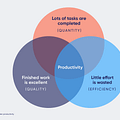Like me, you love to work smarter and accomplish things faster .
Am I Right?
Every time you try, something or the other comes your way and keeps you from working smarter.
If you’ve ever wanted to work smarter and accomplish things faster, then you’re reading the right article.
That’s because you’re about to discover my easy 6 -step method for building a smart working framework.
When I got promoted as a Coordinator 15 years back, everyone would ask me to divide the work, make a system of my own, etc.
But it simply would not get into my head.
I had a tough time learning it, but I don’t want you to go through the same difficulties, so I want to help you with designing a smart working framework as simply and effortlessly.
But before you dive deep into the steps, let me explain to you what a framework is, why it is important and the only 6 steps that you will need to go through to develop a smart working framework.
So stayed glued till the end …
WHAT IS A FRAMEWORK
A framework is a supporting structure or a backbone underlying a system or concept.
A framework serves as a robust foundation to boost your efficiency.
WHY IS IT IMPORTANT TO HAVE A FRAMEWORK
Having a framework is beneficial in many respects.
-
It saves you time.
-
It Gives a structure and helps you work efficiently.
-
It reduces the risks of error.
-
It simplifies the way you work and makes life easier.
-
It gives you consistency, makes your days predictable, and makes you feel safe and secure.
-
It helps you to focus your time and energy on the most important tasks that will bring you growth and fulfillment.
-
It helps you to stay in control of the important things.
A SMART WORK FRAMEWORK HAS 6 PILLARS
They are –
STEP 1-GOAL AND TASKS TO ACCOMPLISH THE GOAL
STEP 2- OUTLINING YOUR TOP PRIORITIES FOR THE WEEK
STEP 3 -EFFECTIVE SCHEDULING
STEP 4- MANAGING YOUR ATTENTION
STEP 5 -DELEGATION
STEP 6 -ACCOUNTABILITY -FROM SELF AND OTHERS
Get these 23 Productivity Hacks to Work Smarter, Get more done and find Fulfilment and Balance Here !
So let’s start with the steps one by one.
1 ‘’HAVE A GOAL IN PLACE ‘’
Many people who become Managers for the first time or are newly promoted, don’t even realize that they need to do this step before they can get clear on their Priorities. And that’s why a lot of New Managers who try to work smarter end up failing -because they’re missing this crucial step.
So the first thing you need to do is to take a goal or project that you want to accomplish.
Decide on the goal or project you want to accomplish. It can be, working on a new project, team building, developing efficient systems, etc. Set a time frame to achieve it.
Define the success parameters. Be thorough here.
You’ll find this part of the process goes much more smoothly if you ask these questions
What is the most important Goal that I Want to accomplish?
Why do I want to accomplish it?
What benefits will I get if I accomplish it?
How will it impact me and others around me?
How much time will it require?
What are the skills needed to accomplish it?
What are the tasks needed to complete this?
What resources do I need to accomplish this goal?
What are the challenges around the goal and how will I overcome them?
Once you’ve completed this first step, i.e. getting clear on the goal and the things required to accomplish the goal, then you can move to the next step.
The next step is to develop a list of tasks and resources required to accomplish the goal. Write a list of tasks that you think are needed to accomplish the goal.
The third step is to put the tasks into different categories. Mark all the tasks in the list, that you are good at doing by using the word, say – ME
Now mark all the tasks that need to be delegated or outsourced.-Use the letter D
Now list all the nonessential tasks that are not necessary to accomplish the goal and need to be eliminated –Mark them as E.
Now you have the goal and the list of tasks in place. You are very clear and sorted out. This is the very foundation on which you will build the rest of the frame.
The next step will help you to make decisions on the tasks that you have listed.
In this step, You will classify the tasks into 4 different categories –Tasks that need to be done NOW, tasks that can be done LATER and tasks that can be DELEGATED, and tasks that can be ELIMINATED.
Make 4 columns and name them and put the tasks into each column.
This exercise will help you to shorten the task list and reduce stress. So you are sorted out now.
You now have done the solid groundwork.
Let’s move on to the next step.
2 PRIORITISE THE TASKS
Now let’s prioritize the tasks week-wise.
Ask yourself this question -What comes before everything else, what comes next, and what next?
Keep repeating this question and numbering all the tasks in the boxes till you have nothing left. Give them a rank -Use ABCDE Or 1 2 3 4
In this way, you have them in order of priorities .
To outline tasks for the first week, take the 3 most important tasks for the week. Break them down into 3 to 5 small action steps.
Suppose If I have to plan the posts for the month, I would break them into steps like –Brainstorm topic ideas. Shortlist 3 to 4 topics. Put them in the editorial calendar. Assign tentative dates to publish them. Create outlines for the topics of the posts. Make a list of links or books from which to curate the topics for the posts. All this is one week’s work.
TIP -Do not treat all tasks as the same. Batch similar tasks together. This will cost you less time, energy and help you work faster.
I batch my tasks like this for writing blogs —
I plan out the 3 to 4 content topics for the month.
Then I make outlines for all the 3 to 4 posts that I need to write.
Next, I organize the materials for the topics.
Then I complete writing the posts.
Then I edit them together.
Next, I select images and publish them.
Then I schedule them together on Buffer.
This takes less time and helps me to do it faster .
Read the article on –HOW TO USE THE ACTION PRIORITY TOOL TO PRIORITIZE ALL YOUR ACTIONS
3 CREATE A SCHEDULE THAT IS EFFECTIVE AND SUPPORTS YOU
Creating a schedule is the next important step to building a smart working framework.
A schedule helps you to leverage your work hours according to your peak energy times and work more effectively.
Take a weekly planner. From morning to bedtime, block times of the day for your important activities like, wake up, exercise, getting ready, commuting time, lunch, dinner time, family time, rest time, and going to bed.
Now in the work hours, make 3 to 4 blocks of 75 to 90 minutes with 10 minutes of break time in between
Reserve the first block for making the to-do list for the day, communicating and delegating tasks to people for the day –This will take a maximum of 45 minutes of your time in the morning.
Reserve the next block for your project tasks -where you will do your goals. They are high effort and high impact tasks like goals and projects. Reserve 90 minutes for this task
Reserve the next block of say an hour or 75 minutes for some medium effort tasks that have a high impact and require only one hour to accomplish but are highly impactful.
Reserve another 60 minutes for low effort and low impact tasks like answering emails.
Set aside another 30 to 45 minutes reviewing the day, taking accountability of the tasks done, and planning for the next day.
In this way, you get a focused and predictable schedule for the week.
My schedule looks like this .
| MON | TUE | WED | THUR | FRI | |
| 11.00 TO 12.30 MARKETING | write blog | REVIEW AND PLAN NEXT WEEK | |||
| 12.45 TO 1.30
SOCIAL MEDIA |
network | ||||
| 2.00 TO 3.00 PM
EMAILS |
answer emails | ||||
| 4.00 TO 5.30 PM
PROJECT TASKS |
work on project tasks | REVIEW AND PLAN NEXT WEEK |
NOTE –
Reserve some discretionary time in your schedule to work on your goals and priorities.
Set aside time to deal with contingencies, unpredictable events, and interruptions.
Keep aside time to plan and review and analyze your own progress and tasks that are delegated and outsourced.
4 MANAGE YOUR ATTENTION
‘’Attention energizes and intention transforms .’’- Deepak Chopra
A most widely held belief is that managing time is the foundation of productivity, but I believe the opposite to be true.
You cannot make the future come soon or go back to the past. At best you can only take one tiny step each day.
What you do today will become your future tomorrow.
If you block off your time in your schedule to work, but spend those hours managing emails, phone calls, or browsing different websites or social media platforms, or thinking of meeting an old friend or catching up with the latest news, then you are not paying attention to the task at hand because you are mismanaging your attention.
Managing your time is a misconception, manage your attention instead.
Keep a check on your attention while you are doing the work.
When you are working, be into it head, heart, and soul.
If you are working on a project and stressing over having to meet a friend in the evening, then you are not attentive.
So keep a check on your state of mind, be aware of whether you are fully present or partially present.
If there is any one ‘secret’ to effectiveness, it is concentration.
—Peter F. Drucker
Distractions will always show up--internal, like thinking of going to a movie or meeting on an old friend or going to a party, as well as external like phone calls, urgent meetings, or emails, but you must be firm and rise above them and focus on the most important tasks for the day.
So better train your mind to manage your attention. You will be ahead of most around you.
Be clear with your intentions and you will be able to direct your energy to the most vital task and progress faster towards your goals.
This is why the earlier 3 steps -having a goal, having clear priorities, and having an effective schedule helps you to focus your attention on the most important tasks that will help you progress consistently and stay on track.
Ask yourself a question –’’ What is the most important task for me to focus on right now? How will I make the best use of my energy ?’’
If you are clear with yourself, it will become easier for you to say NO to the less important things.
So by now, you have completed the first 4 essential steps of designing a smart working framework.
Having worked at the personal level, now we will move on to the 5 th step, delegating tasks to others.
5.DELEGATE
If you spend too much time on unnecessary meetings and micromanaging the tasks of your employees, or doing all the things by yourself ,you will end up stressed and will take more time than usual to accomplish them.
Delegation is a powerful tool that will help you to work faster and save you more time for yourself.
By saving that time, you will be left with more time for important things like Gaining clarity on important matters, working on goals and projects, developing good relationships with employees, improving inefficient systems, communications, and planning that will help to grow you as well as your employee
Delegation saves you from unnecessary stress, workload overwhelm or running behind.
It is good for your own as well as your team’s advancement.
You must delegate tasks that are high in effort and low in impact to people who are good at them and can do it faster than you.
To Delegate Effectively –
1 Get clear on what tasks you want to delegate, who you want to delegate, and set a time frame for it.
Be clear on the expectations and performance of employees.
2 Be clear on how much authority you want to give your employee so that he is comfortable in working without having to take your approval at each step and feel freer to accomplish it faster.
3.Identify what tools and resources they will need to accomplish the work and help them with those tools and resources.
4 .Identify all the challenges that can arise.
It will be good if you spend some time with your employee brainstorming the possible challenges and how they will overcome them.
This will prepare them better and help them in getting the work done faster.
Ask them for their ideas on how they would like to get it done.
Be concerned with the result.
5 Communicate regularly and take regular updates on the progress. Find out where they are stuck or what problems they are facing. Help them unblock themselves by asking questions and brainstorming. Regular communication helps to solve problems that arise and helps in making quick progress. Keep reminding them of the deadline and inform them how important it is to the whole organization.
NOTE –
Review progress regularly.
Give tasks according to employees’ competencies and double confirm their commitment.
Be a mentor to them. Help them set goals.
Have regular follow-up.
Now it is time to get good at accountability.
6 ACCOUNTABILITY FROM SELF AND OTHERS
Accountability is the most critical step after doing all the steps because without keeping accountability all else will fail.
First let me explain what is accountability, why it is is important and how it benefits you,
Accountability means taking responsibility for all the decisions, actions, performance, and behavior of all the employees. It is a collective responsibility of all the employees together as a whole.
If the employees in the workplace are accountable they will take ownership of the outcomes. The managing body will be saved of the time and effort to pick up the slack from time to time.
Accountability is important because if people are not held accountable, then the productivity of all suffers as a whole. Few responsible will have to bear the burden of those who are irresponsible, it will lower the productivity of the team /organization in the long run.
Accountability is beneficial to you because –
-
It fosters creativity and innovation
-
Helps you in doing the right things and stay on track.
-
If you keep yourself and others accountable. There is better commitment and performance and more trust.
-
It increases the engagement, and morale of the team, and brings more fulfillment. It reduces turnover rates.
To keep accountability:
Use a tool such as an accountability log.
Have regular updates. Encourage transparency.
Reserve time in your schedule each day and weekend to track the progress of the work.
Know where they are faltering and why. Mentor them and encourage them to find solutions.
Appreciate their progress.
Reward them from time to time.
CONCLUSION
And there you have it – a simple 6 step method for designing a Smart Working framework.
Now that you know how to make a smart working framework, there’s just one thing left for you to do: take action.
So get to it, and soon you too will enjoy working smartly and faster.
But before you get started, I would like to mention a point that you need to keep in mind.
All change requires a change of habits and mindsets and must be a gradual process, or else you will fall flat.
Take one step at a time. get better at one thing and then the next and next and so on.
The habits that you need to work smarter are -setting personal and career goals regularly, setting realistic and achievable goals, outline your priorities regularly, plan your day and week, manage your attention, delegate as much as possible, track progress consistently, and measure them. Instead of micromanaging, keep an overview of things.
Keep a progressive mindset and stop perfectionism, Instead of doing it all by yourself, delegate.
Appreciate the accomplishments of your employees, communicate with them as often as possible .
Hold yourself and others are accountable.
Be a mentor to them. Help them develop their skills and knowledge. Encourage participation of all.
Keep learning from your mistakes and growing with each experience.
Having a framework is the first step .You also need to have relevant tools to help you at each step to help you work seamlessly and be on track .Read the article ”13 Productivity tools that every New Manager Must have .”
You have learned how to make a smart work framework for yourself. What are you committing to doing right now? Or Do You have any other Framework for Working Smarter . Please share your comments.
If you’re curious about learning more about working smarter , I support managers at all levels with coaching specifically on this powerful topic. If this sounds like you and you’d like to explore how coaching can help, please schedule a FREE DISCOVERY SESSION HERE NOW.
Babita Sharma
Leadership Coach
www.leadwithpassion.co.in
P.S- Please share the post and help someone today .
REFRENCES
13 REASONS WHY NEW MANAGERS MUST WORK SMARTER TO SUCCEED IN THEIR CAREER
SMART WORK VS HARD WORK AND WHY YOU MUST CHOOSE SMART WORK?
18 MISTAKES THAT PREVENT NEW MANAGERS FROM WORKING SMARTER
24 SMART WORKING TIPS THAT WILL MAKE NEW MANAGERS HIGHLY SUCCESSFUL








